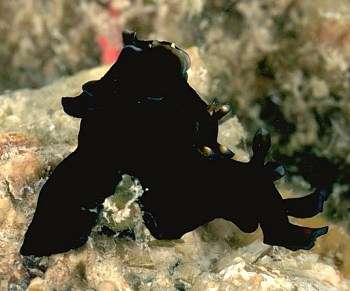
Aplysia cf. parvula
Guilding in Morch, 1863
Order: ANASPIDEA
Superfamily: APLYSIOIDEA
Family: Aplysiidae
DISTRIBUTION
Indo-West Pacific
PHOTO
Two animals, one much smaller than the other. The small animal stayed on top of the larger, with its penis inserted in the larger animal for at least 2 days. Koumac, New Caledonia, October 1993. 14, 33mm long alive. PHOTO: Bill Rudman.
This dark brown Aplysia with paler borders to the parapodia and to the rhinophores and oral tentacles is relatively common in the western Pacific. It has a similar size range, and shape, to Aplysia parvula and is usually considered a colour form of that species.
See the General Topics List for more information on Sea Hares.
Reference:
• Morch, O.A.L. (1863). Contributions a la faune malacologique des Antilles danoises. Journal de Conchyliologie 11: 21-43.
Rudman, W.B., 1999 (April 25) Aplysia cf. parvula Guilding in Morch, 1863. [In] Sea Slug Forum. Australian Museum, Sydney. Available from http://www.seaslugforum.net/find/aplycfpa
Related messages
Aplysia cf parvula from Indonesia
December 7, 2006
From: Indra Swari
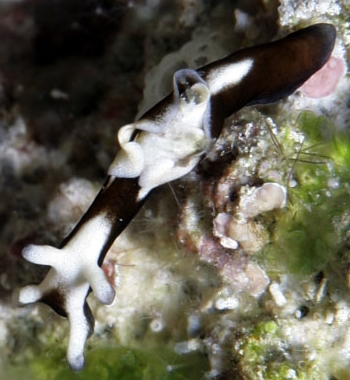
Hi Bill,
Read through some books but can't find a perfectly match ID with this photo. Can you help me ID this?
Locality: Bunaken Island, 6 meters, North Sulawesi, Indonesia, 29 October 2006. Length: 3 cm. Photographer: Indra Swari.
Indra Swari
ungu@terong.com
Wonowidjojo, I. S., 2006 (Dec 7) Aplysia cf parvula from Indonesia. [Message in] Sea Slug Forum. Australian Museum, Sydney. Available from http://www.seaslugforum.net/find/18932Dear Indra,
This is a sea hare which I am at present calling Aplysia cf. parvula. Whether or not it is a colour form of Aplysia parvula is hard to say at present.
Best wishes,
Bill Rudman
Aplysia cf. parvula from the Red Sea
March 22, 2006
From: Oren Lederman
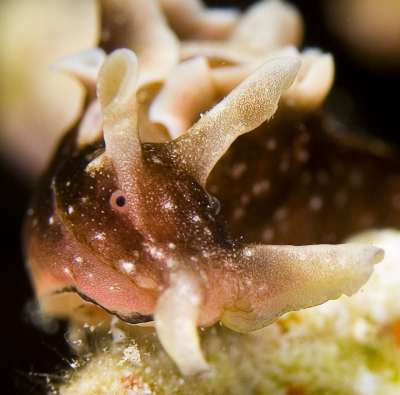
Hi Bill,
Found this one last weekend. Is it Aplysia parvula?
Locality: The Reservation, ~20 meters, Israel, Red Sea, 10 March 2006, Coral heads. Length: 2-3 cm. Photographer: Oren Lederman.
Oren Lederman
lederman@bigmail.co.il
Lederman, O., 2006 (Mar 22) Aplysia cf. parvula from the Red Sea. [Message in] Sea Slug Forum. Australian Museum, Sydney. Available from http://www.seaslugforum.net/find/16124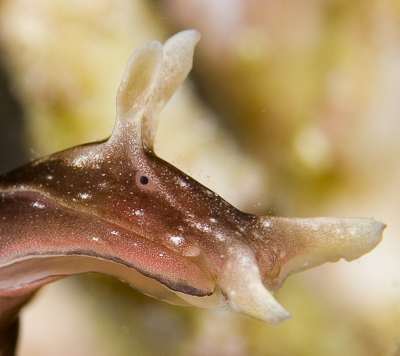
Dear Oren,
Yes this is the form I am calling Aplysia cf. parvula. Whether it is a colour form of Aplysia parvula or a separate species will need some anatomical research.
Thanks for these great close-ups of the head. They show the 'ear-shaped' rhinophores very well, and in the photo alongside, the sperm groove can be seen running along the right side of the head.
Best wishes,
Bill Rudman
Aplysia cf parvula from the Red Sea
May 25, 2005
From: Oren Lederman
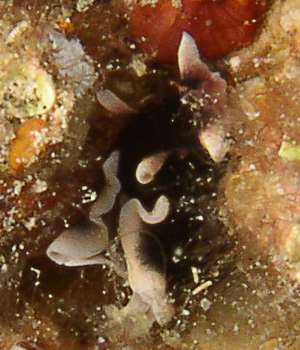
Hi Bill,
Here are two Aplysia cf parvula me and my dive buddy found during a dive last weekend (bottom two photos of second animal)
Locality: "Dekel" beach. Eilat, Israel. Red Sea. Depth: ~20 m. Length: ~1 cm .13 May 2005. Photographer: Oren Lederman
Oren Lederman
lederman@bigmail.co.il
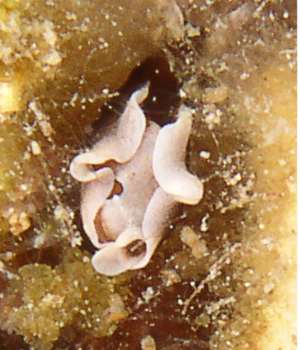
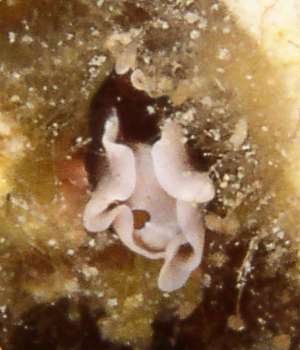
Thanks Oren,
In the lower photos you can see traces of the brown shell, so typical of A. parvula. These animals have a broader whitish edge than usual.
Best wishes,
Bill Rudman
Aplysia cf. parvula from Mayotte
December 16, 2003
From: Marina Poddubetskaia
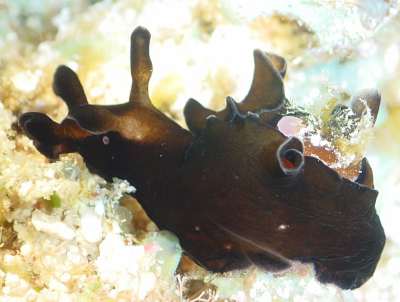
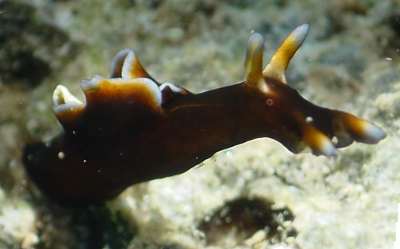
Dear Bill,
Aplysia cf. parvula is also present in Mayotte. But while the typical Aplysia parvula is found in the red alga (see my previous message), these black specimens were seen in the open area, just on the rocks. In fact, I have never seen any dark Aplysia parvula in the red algae, only reddish ones.
In Mayotte I've collected both red and black Aplysia, so I hope one day we will know if they are of the same species.
Bill, please note the small 'garden' on the foramen of the first specimen :-)
Upper Photo 1: November 02, 2003. Location : N'gouja, Mayotte Island, Indian Ocean. Site: Passe Bateau., Depth: 14m., Size: 25mm [also close-up of foramen with algal growth].
Middle Photo: November 05, 2003. Location: Mayotte Island, Indian Ocean., Site: Passe en S, buoy n° 3. Depth: 3.5m., Size: 15mm
Best wishes,
Marina.
nembro@nembro.info
Poddubetskaia, M., 2003 (Dec 16) Aplysia cf. parvula from Mayotte. [Message in] Sea Slug Forum. Australian Museum, Sydney. Available from http://www.seaslugforum.net/find/11666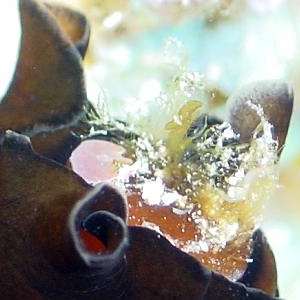
Dear Marina,
Thanks for these photos. It is interesting that both Scott Johnson [see his earlier message] and I consider this to be a colour form of Aplysia parvula. I realise it's not very scientific, but when you have seen a these animals in the field they certainly mirror the ways of A. parvula. You say that 'typical' A. parvula is always found in red algae. But that is the crux of the problem - What is typical A. parvula?. In fact the question of its food may in fact be the answer. Perhaps these black animals are feeding on an alga which darkens their skin? Both your photos shows traces of a black or bluish-black band around the parapodial edge as found in 'typical' A. parvula. Often in Aplysia cf. parvula the parapodial edge seems white or very pale - and that is emphasised by the very black or dark brown of the rest of the animal - but if you look carefully there are often traces of black pigmentation at the edge. I am pretty sure this is a form of A. parvula but am leaving it on a separate page at present so we can be aware of the differences.
The algal garden reminds me of the similar garden on the shell of the animal in the Haminoea cymbalum Fact Sheet. These opportunistic green algae, such as Enteromorpha, settle and grow very quickly on clean surfaces. They don't last long but by growing quickly they can complete a reproductive cycle before being crowded out by some other organism, either plant or animal. It is unlikely that anything else will replace these green algae on the Aplysia shell because the animal is relatively short-lived.
Best wishes
Bill Rudman
Aplysia cf. parvula from Mauritius
November 16, 2002
From: Marina Poddubetskaia
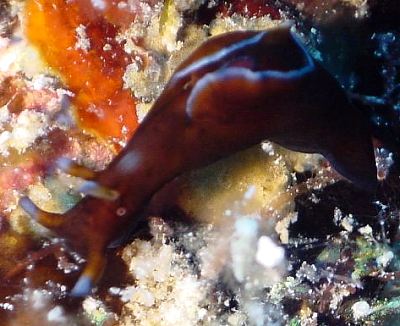
Dear Bill,
Here are some photos of what you are calling Aplysia cf. parvula. In Mauritius I found two colour forms : brown and black.
Upper and Lower Left: Pereybere, Mauritius, Indian Ocean. Site: Malen. Depth: 19m. Size: 10-15mm. October 18, 2002. Lower Right: Pereybere, Mauritius, Indian Ocean. Site: Jardin de Corail. Depth: 17m. Size: about 15mm. October 18, 2002. Photos: Marina Poddubetskaia - Nembro website
Best wishes,
Marina.
nembro@nembro.info
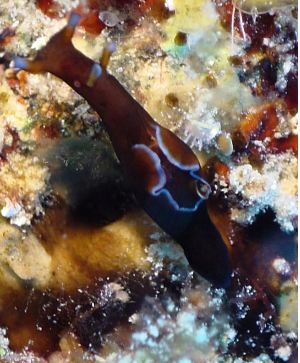
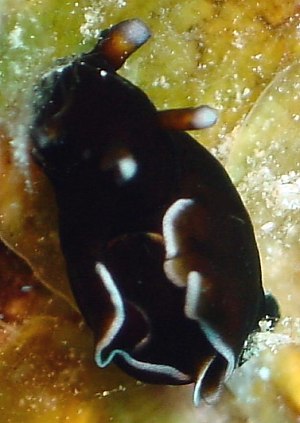
Thanks Marina,
Bill Rudman
Re: Aplysia cf. parvula (?) from the Red Sea
April 7, 2002
From: Erwin Köhler
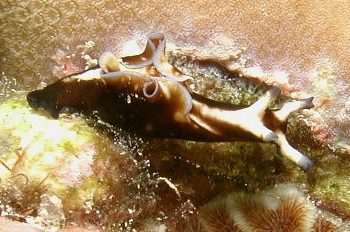
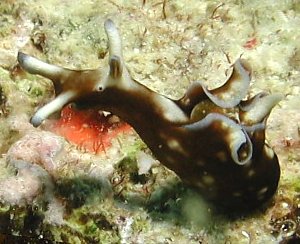
Dear Bill,
On my recent trip to the Philippines I found this Aplysia cf. parvula again. I collected 2 of them and brought them to the next resort, where an other slugmaniac (Brigitte) spent her holidays. In the box they started mating, so they must have been adults - their sizes: 16mm and 18mm, pretty much smaller than the Red Sea one. Brigitte placed them again in the sea and got some shots of them too. We did this procedure (with other seaslugs) several times - I guess she is still wondering how I find these little creatures ...
and I had several drinks on her!
Data: the Philippines: Cebu Island, Moalboal, "Sea Explorers" housereef,
depth 7m, 11.March 2002.
At my website are shots of 2 similar looking specimens from the Maldives at from the the Philippines in March 1999.
All of them were less than 2cm long...
Erwin
Erwin@medslugs.de
Köhler, E., 2002 (Apr 7) Re: Aplysia cf. parvula (?) from the Red Sea. [Message in] Sea Slug Forum. Australian Museum, Sydney. Available from http://www.seaslugforum.net/find/6647Thanks Erwin,
Bill Rudman
Aplysia cf. parvula (?) from the Red Sea
March 30, 2002
From: Dr. Jacob Dafni
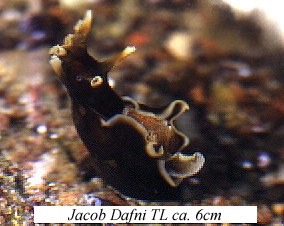
Dear Dr. Rudman
Upon searching Aplysid pictures in your list, I found your identification of a dark specimen from the Philippines. The attached picture, taken at Eilat, Red Sea in 1997, seems to me of the same pattern. It was ca. 6 cm large.
Actually, A. parvula was recorded from the Red Sea [Dekker & Orlin (2000) checklist of Red Sea Mollusca. Spirula Newsletter, Vol 47 suppl.]
Dr. Jacob Dafni
jdafni@netvision.net.il
Dafni, J., 2002 (Mar 30) Aplysia cf. parvula (?) from the Red Sea. [Message in] Sea Slug Forum. Australian Museum, Sydney. Available from http://www.seaslugforum.net/find/6538Dear Jacob,
Yes this certainly looks like the species I have seen at odd times throughout the Indo-West Pacific. Considering how many names have been given to Sea Hares from this region I would be surprised if there isn't one to fit it, but I have not discovered it as yet.
True A. parvula has a circumtropical distribution and has been recorded from many parts of the Indo-West Pacific and the Atlantic Oceans. It has been known from the northern Indian Ocean [Aden] from at least 1960 (Eales, 1960).
Best wishes,
Bill Rudman
Unknown Aplysia from the Philippines
April 25, 1999
From: Erwin Koehler
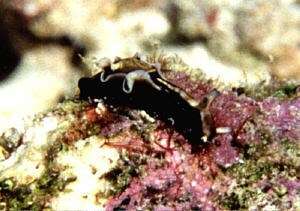
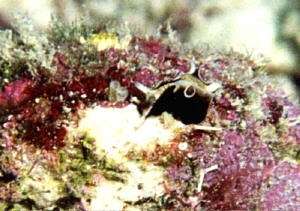
Bill,
A small sea hare (17 mm), Philippines, Cebu Is., divesite: Kasai, 17m depth, March 1999
Any idea?
Erwin
Medslugs.Koehler@t-online.de
Koehler, E., 1999 (Apr 25) Unknown Aplysia from the Philippines. [Message in] Sea Slug Forum. Australian Museum, Sydney. Available from http://www.seaslugforum.net/find/802These little Sea Hares with almost reversed colouration to Aplysia parvula , have usually been considered a colour form of that species. I am not altogether convinced. One problem with Sea Hare taxonomy though is the large number of names based on preserved species. Even in her 1960 major revision of the genus, Nellie Eales, in an act which I could only adequately describe in very rude words, named even more new species entirely from shrunken decolourised museum species.
Best wishes,
Bill Rudman.
